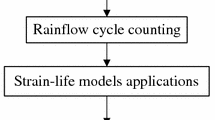Abstract
A randomized approach is developed to solve a deterministic equation. The method uses random deterministic approach to achieve the fatigue life based on residual strength and S-N curve. We propose a one-to-one transformation method to deduce the distribution of fatigue life from the residual strength. The proposed method is simple and effective, and can be used for fatigue life prediction. An example is given to illustrate how the method works.
Similar content being viewed by others
References
Fatemi A, Yang L. Cumulative fatigue damage and life prediction theories: A survey of the state of the art for homogenous materials [J]. Internationl Journal of Fatigue, 1998, 20(1): 9–34.
Zhu S P, Huang H Z, He L P, et al. A generalized energy-based fatigue-creep damage parameter for life prediction of turbine disk alloys [J]. Engineering Fracture Mechanics, 2012, 90: 89–100.
Zhu S P, Huang H Z, Wang Z L. Fatigue life estimation considering damaging and strengthening of low amplitude loads under different load sequences using fuzzy sets approach [J]. International Journal of Damage Mechanics, 2011, 20: 876–899.
Newman Jr J C, Phillipsa E P, Swainb M H. Fatigue-life prediction methodology using small-crack theory [J]. International Journal of Fatigue, 1999, 21: 109–119.
Shang D G, Yao W X. A non-linear damage cumulative model for uniaxial fatigue [J]. International Journal of Fatigue, 1999, 21(2): 187–194.
Luo X, Luo R, Lytto R L. Energy-based mechanistic approach for damage characterization of pre-flawed visco-elasto-plastic materials [J]. Mechanics of Materials, 2014, 70: 18–32.
Manson S S, Halford G R. Practical implementation of the double linear damage rule and damage curve approach for treating cumulative fatigue damage [J]. International Journal of Fracture, 1981, 17(12): 169–192.
Papadopoulos I V. Long life fatigue under multiaxial loading [J]. International Journal of Fatigue, 2001, 23: 839–849.
Dai J, Das D, Ohadi M, et al. Reliability risk mitigation of free air cooling through prognostics and health management [J]. Applied Energy, 2013, 111: 104–112.
Zhu S P, Huang H Z, Liu Y, et al. A practical method for determining the Corten-Dolan exponent and its application to fatigue life prediction [J]. International Journal of Turbo and Jet Engines, 2012, 29(2): 79–87.
Chaboche J L, Lesne P M. A non-linear continuous fatigue damage model [J]. Fatigue and Fracture of Engineering Materials and Structures, 1988, 11(1): 1–7.
Cheng G X, Plumtree A. A fatigue damage accumulation model based on continuum damage mechanics and ductility exhaustion [J]. International Journal of Fatigue, 1998, 20(7): 495–501.
Chaboche J L. Continuum damage mechanics. PartII. Damage growth, crack initiation and crack growth [J]. Journal of Applied Mechanics, 1988, 55(1): 65–72.
Shen H, Lin J, Mu E. Probabilistic model on stochastic fatigue damage [J]. International Journal of Fatigue, 2000, 22(7): 569–572.
Gatts R R. Application of a cumulative damage concept to fatigue [J]. Journal of Fluids Engineering, 1961, 83(4): 529–534.
Lemaitre J, Plumtree A. Application of damage concept to predict creep-fatigue failures [J]. Journal of Engineering Materials and Technology, 1979, 101(3): 284–292.
Kim J, Yi J, Zi G, et al. Fatigue life prediction methodology using entropy index of stress interaction and crack severity index of effective stress [J]. International Journal of Damage Mechanics, 2013, 22(3): 375–392.
Liu Y, Mahadevan S. Stochastic fatigue damage modeling under variable amplitude loading [J]. International Journal of Fatigue, 2007, 29(6): 1149–1161.
Liao M, Xu X, Yang Q. Cumulative fatigue damage dynamic interference statistical model [J] International Journal of Fatigue, 1995, 17(8): 559–566.
Rathod V, Yadav O P, Rathore A, et al. Probabilistic modeling of fatigue damage accumulation for reliability prediction [J]. International Journal of Quality, Statistics, and Reliability, 2011, doi: 10.1155/2011/718901 (published online).
Wu W F, Huang T H. Prediction of fatigue damage and fatigue life under random loading [J]. International Journal of Pressure Vessels and Piping, 1993, 53(2): 273–298.
Meneghetti G. Analysis of the fatigue strength of a stainless steel based on the energy dissipation [J]. International Journal of Fatigue, 2007, 29(1): 81–94.
Morel F. A critical plane approach for life prediction of high cycle fatigue under multiaxial variable amplitude loading [J]. International Journal of Fatigue, 2000, 22: 101–119.
Pavlou D G. A phenomenological fatigue damage accumulation rule based on hardness increasing for the 2024-T 42 aluminum [J]. Engineering Structures, 2002, 24(11): 1363–1368.
Shang De-guang, Yao Wei-xing. Study on non-linear continuous damage cumulative model for uniaxial fatigue [J]. Acta Aeronautica ET Astronautica Sinica, 1998, 19(6): 647–656 (in Chinese).
Lagoda T, Macha E, Nieslony A. Fatigue life calculation by means of the cycle counting and spectral methods under multiaxial random loading [J]. Fatigue & Fracture of Engineering: Materials & Structures, 2005, 28(4): 409–420.
Miller K J, Zachariah K P. Cumulative damage laws for fatigue crack initiation and stage I propagatoin [J]. Journal of Strain Analysis for Engineering Design, 1977, 12(4): 262–270.
Author information
Authors and Affiliations
Corresponding author
Additional information
Foundation item: the National Natural Science Foundation of China (No. 11302044)
Rights and permissions
About this article
Cite this article
Zuo, Fj., Zhu, Sp., Gao, Hy. et al. Stochastic fatigue life and reliability prediction based on residual strength. J. Shanghai Jiaotong Univ. (Sci.) 20, 331–337 (2015). https://doi.org/10.1007/s12204-015-1632-9
Received:
Published:
Issue Date:
DOI: https://doi.org/10.1007/s12204-015-1632-9




